Canadian Economy
Canadian Economy
Mining, energy and manufacturing drive GDP higher in February.
After a poor start to the year, the Canadian economy recovered strongly in February. January saw overall GDP fall on weakness in energy and mining, but a recovery in those same industries, along with a solid bump in manufacturing, pushed economic growth in February to its highest monthly rate since last May. All told, value-added output across the country rose by 0.43 per cent in February – equivalent to an annualized increase of 5.3 per cent.
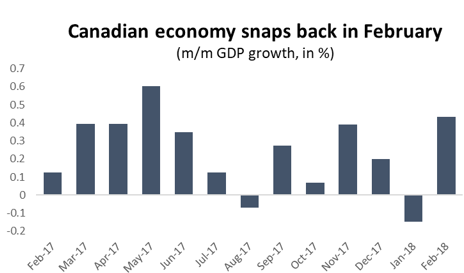
Graph demonstrating that the Canadian economy snapped back in February. Economic Analysis: GDP, February 2018.
The resource-led recovery in the Canadian economy also helped boost year-over-year growth, which had been gradually decelerating since last summer. February’s GDP numbers came in at just over 3.0 per cent higher compared to 12 months earlier, up from 2.7 per cent in January. That said, year-over-year growth is still expected to slow in the coming months as the Canadian economy is unlikely to match last spring’s surge in 2018.
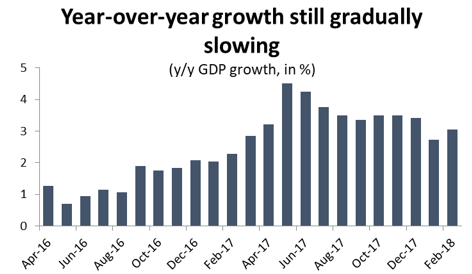
Graph showing that the year-over-year growth is still gradually slowing. Economic Analysis: GDP, February 2018.
As suggested above, February’s solid growth numbers were driven by a reversal in Canada’s extractive industries, and in goods production generally. GDP in good-producing industries rose by 1.2 per cent compared to January, while the services sector grew by just 0.13 per cent. Within the goods sector, GDP in energy and mining rose by 2.4 per cent in February, erasing most of the 2.9 per cent decline the previous month. There were also solid gains in manufacturing (1.0 per cent) and in construction (0.7 per cent).
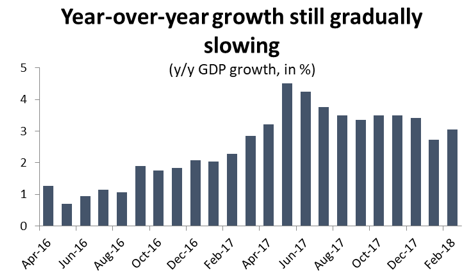
Graph showing that the year-over-year growth is still gradually slowing. Economic Analysis: GDP, February 2018.
Results were generally positive in services industries as well, although considerably more muted. There were solid gains in arts and culture industries (up 1.4 per cent compared to January), as well as in professional and scientific services (0.6 per cent). At the same time, the spike in goods production meant a corresponding increase in demand for transportation services; GDP in that industry was up 0.5 per cent in February. On the down side, wholesale trade activity fell 0.5 per cent compared to January and, more interestingly, GDP in real estate and leasing industries fell for the second month in a row. Efforts to cool the white-hot housing market in Toronto, and BC’s lower mainland appear to be having some effect. GDP in real estate and leasing has not fallen for two consecutive months since 2010.

Graph showing GDP growth by sector. Economic Analysis: GDP, February 2018.
Looking at the manufacturing sector, the 1.0 per cent growth in February builds off a strong showing in January and suggests that economic momentum is starting to develop in the sector. On a year-over-year basis, manufacturing GDP is up 4.9 per cent compared to the same point in 2017, compared to 3.0 per cent for the economy as a whole. Much of the growth in manufacturing has taken place in the last six months.
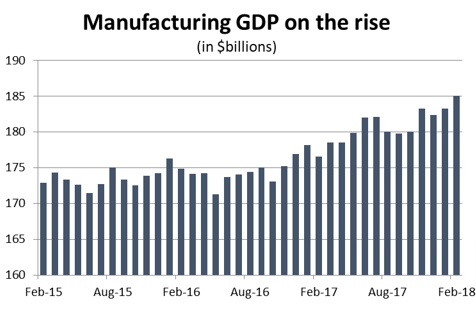
Graph showing that manufacturing GDP is on the rise. Economic Analysis: GDP, February 2018.
Within the sector, gains in February were widespread as nine of the 11 major product groupings posted higher GDP numbers. Only chemicals production and food processing saw lower GDP compared to January.
Two industry groupings led the way on the positive side: value-added output in fabricated metals was up 4.4 per cent since January; while GDP in motor vehicles and parts production was up 3.4 per cent. The gains in fabricated metals continue a recent trend of exceptional growth in those industries, while gains the auto sector reflect the recovery of losses in January.
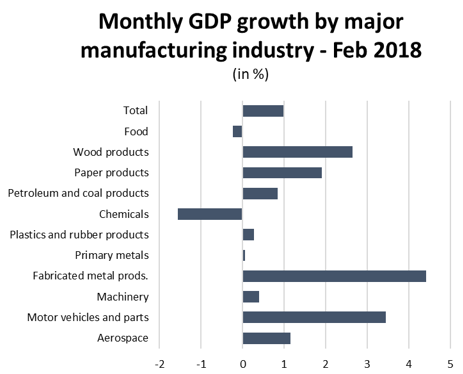
Graph showing monthly GDP growth by major manufacturing industry, Economic Analysis: GDP, February 2018.
Outside of motor vehicles and fabricated metals, there were solid gains in forestry industries, as GDP in both wood and paper products were higher (2.6 per cent and 1.9 per cent, respectively). Meanwhile, aerospace activity was up 1.2 per cent and value-added petroleum refining was 0.8 per cent higher.